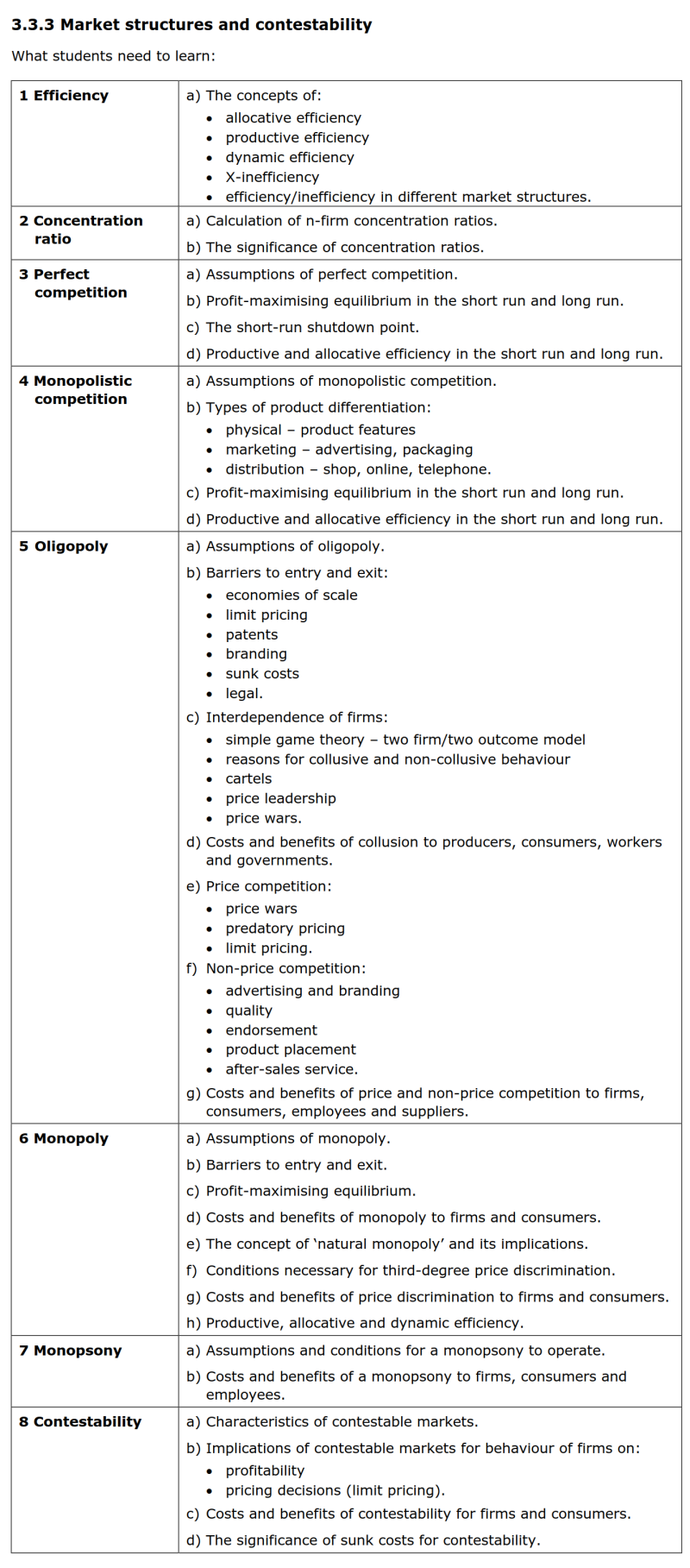Edexcel IAL U3 revision - Section 3 (2018)
如遇到公式加载异常,请刷新页面!
Section 3 Market structures and contestability 市场结构和可竞争性
- 大纲要求
1. Efficiency 效率
a) The concepts of: 掌握下列概念:
• allocative efficiency 分配效率
• productive efficiency 生产效率
• dynamic efficiency 动态效率
• X-inefficiency X无效率
• efficiency/inefficiency in different market structures. 不同市场结构中的效率或无效率
2. Concentration ratio 集中率
a) Calculation of n-firm concentration ratios. 计算n家企业的集中率
b) The significance of concentration ratios. 集中率的重要性
3. Perfect competition 完全竞争
a) Assumptions of perfect competition. 完全竞争的假设
b) Profit-maximising equilibrium in the short run and long run. 短期和长期在利润最大化下的均衡
c) The short-run shutdown point. 短期倒闭点
d) Productive and allocative efficiency in the short run and long run. 短期和长期的生产效率与分配效率
4. Monopolistic competition 垄断性竞争
a) Assumptions of monopolistic competition. 垄断性竞争的假设
b) Types of product differentiation: 产品差异化的类型:
• physical – product features 产品——产品特性
• marketing – advertising, packaging 营销——广告、包装
• distribution – shop, online, telephone. 分销——商店、网购、电话
c) Profit-maximising equilibrium in the short run and long run. 短期和长期在利润最大化下的均衡
d) Productive and allocative efficiency in the short run and long run. 短期和长期的生产效率和分配效率
5. Oligopoly 寡头垄断
a) Assumptions of oligopoly. 寡头垄断的假设
b) Barriers to entry and exit: 进入门槛与退出门槛:
• economies of scale 规模经济
• limit pricing 限制性定价
• patents 专利
• branding 品牌
• sunk costs 沉没成本
• legal. 法律
c) Interdependence of firms: 企业间的相互依赖:
• simple game theory – two firm/two outcome model 简单的博弈论——两家企业/两种结果模型
• reasons for collusive and non-collusive behaviour 勾结与非勾结行为的原因
• cartels 卡特尔
• price leadership 价格领导
• price wars. 价格战
d) Costs and benefits of collusion to producers, consumers, workers and governments. 勾结行为对生产者、消费者、工人和政府的成本和收益
e) Price competition: 价格竞争:
• price wars 价格战
• predatory pricing 掠夺性定价
• limit pricing. 限制性定价
f) Non-price competition: 非价格竞争:
• advertising and branding 广告与品牌
• quality 质量
• endorsement 代言
• product placement 产品植入
• after-sales service. 售后服务
g) Costs and benefits of price and non-price competition to firms, consumers, employees and suppliers. 价格与非价格竞争对公司、消费者、雇员和供应商的成本和收益
6. Monopoly 垄断
a) Assumptions of monopoly. 垄断市场的假设
b) Barriers to entry and exit. 进入门槛与退出门槛
c) Profit-maximising equilibrium. 利润最大化下的均衡
d) Costs and benefits of monopoly to firms and consumers. 垄断对企业与消费者的成本和收益
e) The concept of ‘natural monopoly’ and its implications. “自然垄断”的概念及其影响
f) Conditions necessary for third-degree price discrimination. 三级价格歧视的必要条件
g) Costs and benefits of price discrimination to firms and consumers. 价格歧视对企业和消费者的成本和收益
h) Productive, allocative and dynamic efficiency. 生产效率、分配效率与动态效率
7. Monopsony 买方垄断
a) Assumptions and conditions for a monopsony to operate. 垄断企业的假设和条件
b) Costs and benefits of a monopsony to firms, consumers and employees. 垄断对公司、消费者和雇员的成本和收益
8. Contestability 可竞争性
a) Characteristics of contestable markets. 可竞争性市场的特征
b) Implications of contestable markets for behaviour of firms on: 可竞争性市场对企业以下行为的影响:
• profitability 盈利能力
• pricing decisions (limit pricing). 定价决策(限制性定价)
c) Costs and benefits of contestability for firms and consumers. 可竞争性对公司与消费者的成本和收益
d) The significance of sunk costs for contestability. 沉没成本对可竞争性的重要性
